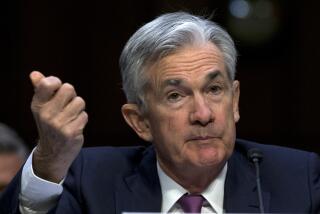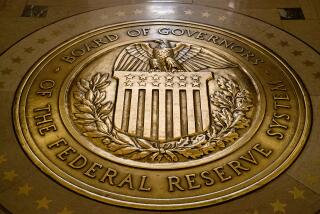A Balancing Act : Chairing the Fed: a Staid Image Helps
- Share via
When a group of U.S. and British generals needed a private place to meet and plan Allied war strategy after the attack on Pearl Harbor, they didn’t go to a military base or the State Department--or even the White House.
They turned to an institution that breathes discretion--the Federal Reserve Board.
“All the years I served on the Fed, there was never even the suspicion of a leak,” said Andrew F. Brimmer, who was on the board from 1966 until 1974. “People keep their mouths shut. The information is on a need-to-know basis.”
Chairman Paul A. Volcker’s resignation from the Fed and the nomination of New York economist Alan Greenspan to be his successor mark a changing of the guard in one of America’s most mysterious and least understood institutions--one that has, nevertheless, vast influence over the nation’s well-being. Through its leverage over interest rates and the amount of cash available in banks, the Fed affects the fortunes of consumers, businesses and even foreign countries.
At Controls of Economy
To boost the economy or to cool it off, “the Fed is often the only game in town,” said Walter Heller, who was chairman of the Council of Economic Advisers under John F. Kennedy and Lyndon B. Johnson. “The chairman is just a very powerful figure.”
In an environment where the economic stakes are global, effective leaders such as the 6-foot-7 Volcker (renowned for his cigar-smoking, although he quit them in March), and his taciturn, white-maned, pipe-puffing predecessor, Arthur F. Burns, attained near legendary stature. Others, like G. William Miller, a Carter Administration appointee who brought an egg-timer to board meetings and limited comments to three minutes, are nearly forgotten.
“There will be a mystique about Alan Greenspan,” joked Milton Friedman, the Nobel Prize-winning economist, “but since he doesn’t smoke pipes or cigars, I don’t know what it will be.”
Imposing Marble Halls
Some of the mystique emanates from the Fed’s two-building complex near the Lincoln Memorial, a classical-looking headquarters built with 40 kinds of marble. It is a place so bound by tradition that the original conference table--still bearing the names of Fed officials in the inaugural year of 1914--is preserved in a special library. The prestige and working conditions--including a tennis court and three dining rooms--have prompted the affectionate nickname “Club Fed” among younger staff members.
But Greenspan will head an institution that is buffeted by the coldest of political winds. The chairman routinely must push some of the least popular policies in government. For example, if inflation is on the rise, the Fed restricts the amount of new money entering the economy, a painful corrective action that caused, for example, the recession of the early 1980s.
Greenspan joins the Fed as the organization’s influence appears to be rising. The buttons it controls--governing the amount of cash in banks and interest rates--are the ones that seem to deal most effectively with the vicissitudes of the world economy. Moreover, Congress and the Administration, overwhelmed by the federal budget deficit, may have lost both the will and the power to guide the nation’s economic future.
“There’s no question that the Fed has become more powerful,” said Donald F. Kettl, a government professor at the University of Virginia and author of the 1986 book “Leadership at the Fed.”
“It’s in part because the chairmen have made use of its resources, and in part because the President and the Congress have found it convenient to let the Fed do the dirty work when inflation gets out of control,” he said.
Expansion and Contraction
Every day, officials influence the amount of money available in the country by placing orders to buy or sell bonds from other banks. The process has the effect of generating and eliminating money. In the course of a year, trillions of dollars may be churned in this way.
The chairman sits down at a big mahogany table eight times a year and convenes a panel, known as the Open Market Committee, to vote on key strategies. The committee is composed of the chairman and six other Fed governors, all presidential appointees, and the presidents of five of the Federal Reserve banks.
The Fed has a certain tradition of consensus (a bronze plaque near the board room fireplace proclaims that the U.S.-British military meetings “set the pattern for Allied collaboration and the successful prosecution of World War II”), but it isn’t easy. Board members must walk a tightrope between pressure from politicians and the financial community. As a result, some say, the institution tries to accommodate the political demands of the moment.
“The institution controls the chairman to a far greater extent than the chairman controls the institution,” said Friedman, a longtime critic of the Fed who says it has caused great economic havoc by bouncing between strategies for short-term political reasons.
Still, the history of the Fed is fraught with examples of chairmen struggling to protect their maneuvering room--and of presidents trying to restrict it. Marriner S. Eccles, a Utah banker, wouldn’t even take the job unless Franklin D. Roosevelt agreed to grant the Fed independence from the Treasury secretary. The President agreed, but years later, Harry S. Truman dumped Eccles for being too independent.
Heller, now a professor emeritus at the University of Minnesota, recalled that Kennedy initially wanted to replace William McChesney Martin Jr., a fatherly, consensus-seeking Truman appointee, but the youthful President was reluctant to do so. “Kennedy’s fear was that if he replaced Martin, it would have an adverse effect on the (financial) markets.” So, Kennedy didn’t replace him.
Heller also recalled the colorful instructions Johnson once gave him on how to interview one potential nominee to the board of governors:
“I literally had to call the candidate for the job and say, ‘the President wants to know that when the quarterback calls the signal, are you going to run to his goal or the other goal?’ Of course, he said he’d run to the President’s goal--but it wasn’t a year before he was running to the other goal.”
Johnson would also cross swords with Martin, who worried that the President’s spending on the Vietnam war and domestic programs was planting the seeds of inflation. In late 1965, Martin successfully promoted an interest-rate hike as a strategy for dampening the economy. He was rewarded with a personal dressing down at the Johnson ranch in Texas.
Later, the professorial Burns, a Richard M. Nixon nominee, would clash with Administration officials over the money supply. The chairman advocated greater expansion and the President resisted. “Nixon, I suspect, thought that when he appointed Burns he had the ultimate loyalist in the job,” said Kettl. “He ended up surprised. Burns was not in his hip pocket.”
Burns also jousted with members of Congress over their efforts to rein in the Fed, including requirements of greater accountability. In addition to roaming the halls himself, he marshaled a potent Fed lobbying network made up of directors from the 12 Federal Reserve banks.
Ultimately, the poorly understood institution let in a little sunlight. The Fed started to publish summaries of its open market panel deliberations--albeit two months after the meetings.
Despite the celebrity of certain chairmen, the position doesn’t automatically confer power. For just over a year in the late 1970s, Miller, an Oklahoma attorney appointed by Jimmy Carter, struggled with volatile interest rates and prices--and never won the financial community’s confidence.
The unhappy situation ended in 1979, when Carter appointed Miller Treasury secretary and named Volcker to replace him at the Fed. The outgoing chairman is lionized for having wrung inflation out of the economy. This was accomplished, however, by resorting to the painfully tight money supply that brought on the worst recession since the Great Depression.
According to Kettl, Volcker’s performance shows how Fed chairmen can influence expectations about the economy with profound effects. Volcker gained such a high degree of confidence in the financial community for his vigilance against inflation that he was able to pursue growth-oriented policies later, without triggering alarm about rising prices.
Thus Volcker, more recently, has presided over a swiftly growing money supply that has abetted a lengthy economic recovery and has not provoked much inflation so far. “The classic trick of a central banker is to convey the image that he will not preside over the engine of inflation--and then to turn up the burners,” said Jerry Jordan, chief economist at First Interstate Bancorp and a former member of Reagan’s Council of Economic Advisers.
It takes a while to build up such an image with Wall Street and the other skittish financial interests that follow each wrinkle of Fed policy with great concern, but the experience of recent Fed chairmen suggests that a little reputation can go a long way.
“The view was that no one but no one could replace William McChesney Martin,” said Jordan. “Then the view was that no one but no one could replace Arthur Burns. Now we’ve had Volcker--and the same view has been built up.
“In eight years, I suspect, there’ll be the same attitude about Alan Greenspan.”
More to Read
Inside the business of entertainment
The Wide Shot brings you news, analysis and insights on everything from streaming wars to production — and what it all means for the future.
You may occasionally receive promotional content from the Los Angeles Times.










